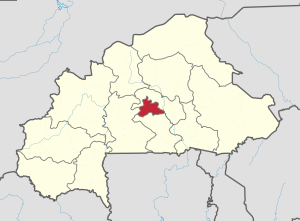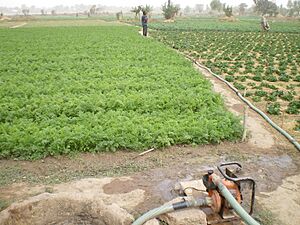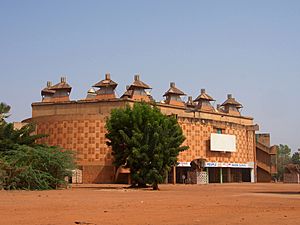Centre Region, Burkina Faso facts for kids
Quick facts for kids
Centre
|
|
|---|---|
|
Region
|
|

Aerial view of Ouagadougou
|
|

Location in Burkina Faso
|
|
| Country | |
| Capital | Ouagadougou |
| Area | |
| • Region | 1,083 sq mi (2,805 km2) |
| Population
(2019 census)
|
|
| • Region | 3,030,384 |
| • Density | 2,798.1/sq mi (1,080.35/km2) |
| • Urban | 2,453,496 |
| Time zone | UTC+0 (GMT 0) |
| HDI (2017) | 0.612 medium · 1st |
Centre is one of the 13 administrative regions in Burkina Faso. It is the most populated and urbanized region in the country. In 2019, about 15% of Burkina Faso's population lived here. The capital city of the Centre region is Ouagadougou, which is also the capital of Burkina Faso. The Centre region has only one province, called Kadiogo.
Contents
What is the Centre Region Like?
Geography and Landscape
Most of Burkina Faso is a wide, flat area called a plateau. This region has three main rivers: the Red Volta, Black Volta, and White Volta. These rivers flow through different valleys. The weather is usually hot, and the amount of rain can change a lot each year.
The dry season lasts from October to May. The wet season, when most of the rain falls, is from June to September. The soil here is quite porous, which means it doesn't hold water well, so farming can be difficult. The land is generally between 200 and 300 meters (about 650 to 980 feet) above sea level.
You can find minerals like gold, quartz, and manganese in the country. Burkina Faso has the largest population of elephants in West Africa, and there are many wildlife reserves. Near the rivers, there are certain insects that can carry diseases, like sleeping sickness and river blindness. The Centre region gets about 25 cm (10 inches) of rain each year. This is less than the southern parts of the country, which can get up to 100 cm (39 inches) of rain.
Who Lives in the Centre Region?
| Historical population | ||
|---|---|---|
| Year | Pop. | ±% p.a. |
| 1985 | 640,108 | — |
| 1996 | 941,894 | +3.57% |
| 2006 | 1,727,390 | +6.25% |
| 2019 | 3,032,668 | +4.42% |
| Sources: | ||
In 2019, the Centre region had a population of over 3 million people. Slightly more than half of the population (50.8%) were female. This region is home to about 14.8% of all the people in Burkina Faso.
The health of children is an important focus. The child mortality rate (children who die before age five) was 80 per 1,000 births.
How Do People Make a Living?
Education is very important in the Centre region. In 2007, the literacy rate (the percentage of people who can read and write) was 63%. This was much higher than the national average of 28.3% at that time.
Many students attend school here. In 2011, the region had 869 primary schools and 354 secondary schools. This means about a quarter of all schools in the country are in the Centre region. The University of Ouagadougou is also located here. In 2010, it had about 40,000 students, which was 83% of all university students in Burkina Faso.
The Centre region is a major hub for transportation. It has many highways and roads that connect to other parts of the country. It is also the end point for the only railway in Burkina Faso. The Ouagadougou International Airport is in this region. From here, you can fly to many big cities in West Africa and even to places like Paris and Brussels.
Farming is also a key part of the economy. In 2015, farmers in the region produced a lot of different crops. These included corn, cowpea, groundnuts, millet, rice, and sorghum.
How is the Centre Region Governed?
| Province | Capital | Population (Census 2019) |
|---|---|---|
| Kadiogo Province | Ouagadougou | 3,032,668 |
Burkina Faso became independent from France in 1960. It was first known as Upper Volta. Over the years, the country has worked to give more power to local communities. This is called decentralization.
Burkina Faso is divided into 13 administrative regions, and each region has a governor. These regions are then split into 45 provinces. The provinces are further divided into 351 communes. Communes can be urban (cities) or rural (countryside). An urban commune usually has about 10,000 people.
Communes are managed by elected mayors. They are responsible for improving the economic, social, and cultural life of their citizens. Communes also have their own money and can work with other communes, government groups, or international organizations.
See also
 In Spanish: Región Centro (Burkina Faso) para niños
In Spanish: Región Centro (Burkina Faso) para niños



